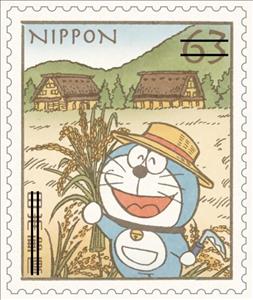Stamp: Doraemon and a rural landscape (Japan 2020)
Doraemon and a rural landscape (Japan 2020)
20 May (Japan ) within release Doraemon (2020) goes into circulation Stamp Doraemon and a rural landscape face value 63 Japanese yen
| Stamp Doraemon and a rural landscape in catalogues | |
|---|---|
| Yvert et Tellier: | Yt: JP 9885 |
Stamp is vertical format.
stamp from mini-sheetAlso in the issue Doraemon (2020):
- Stamp - Mt. Fuji and Doraemon face value 63;
- Mini Sheet - Doraemon face value 10*63;
- Stamp - Pine tree and Doraemon dressed as a traditional mailman face value 63;
- Stamp - Doraemon and a rural landscape face value 63;
- Stamp - Bamboo thicket, bamboo shoot, and Doraemon face value 63;
- Stamp - Doraemon looking at the five-storied pagoda face value 63;
- Stamp - Doraemon tuna fishing with a rod face value 63;
- Stamp - Doraemon enjoying himself at a festival face value 63;
- Stamp - Doraemon having a picnic with a deer face value 63;
- Stamp - Doraemon looking up at willow branches face value 63;
- Stamp - Doraemon picking tea leaves face value 63;
- Stamp - Doraemon’s arrival from the future face value 84;
- Mini Sheet - Doraemon face value 10*84;
- Stamp - Doraemon (first appearance version) face value 84;
- Stamp - Doraemon and Nobita fly with bamboo helicopter face value 84;
- Stamp - Doraemon reading manga while eating face value 84;
- Stamp - Doraemon to call face value 84;
- Stamp - Doraemon and Nobita walking alongside each other face value 84;
- Stamp - Doraemon comes up with a good idea face value 84;
- Stamp - Doraemon and his time kerchief face value 84;
- Stamp - Doraemon and Nobita holding hands face value 84;
- Stamp - Doraemon on the time machine face value 84;
Stamp Doraemon and a rural landscape it reflects the thematic directions:
A cartoon is a type of visual art that is typically drawn, frequently animated, in an unrealistic or semi-realistic style. The specific meaning has evolved, but the modern usage usually refers to either: an image or series of images intended for satire, caricature, or humor; or a motion picture that relies on a sequence of illustrations for its animation. Someone who creates cartoons in the first sense is called a cartoonist, and in the second sense they are usually called an animator.
The concept originated in the Middle Ages, and first described a preparatory drawing for a piece of art, such as a painting, fresco, tapestry, or stained glass window. In the 19th century, beginning in Punch magazine in 1843, cartoon came to refer – ironically at first – to humorous artworks in magazines and newspapers. Then it also was used for political cartoons and comic strips. When the medium developed, in the early 20th century, it began to refer to animated films that resembled print cartoons.
Comics are a medium used to express ideas with images, often combined with text or other visual information. It typically takes the form of a sequence of panels of images. Textual devices such as speech balloons, captions, and onomatopoeia can indicate dialogue, narration, sound effects, or other information. There is no consensus among theorists and historians on a definition of comics; some emphasize the combination of images and text, some sequentiality or other image relations, and others historical aspects such as mass reproduction or the use of recurring characters. Cartooning and other forms of illustration are the most common image-making means in comics; Photo comics is a form that uses photographic images. Common forms include comic strips, editorial and gag cartoons, and comic books. Since the late 20th century, bound volumes such as graphic novels, comic albums, and tankōbon have become increasingly common, along with webcomics as well as scientific/medical comics
A house is a single-unit residential building. It may range in complexity from a rudimentary hut to a complex structure of wood, masonry, concrete or other material, outfitted with plumbing, electrical, and heating, ventilation, and air conditioning systems. Houses use a range of different roofing systems to keep precipitation such as rain from getting into the dwelling space. Houses generally have doors or locks to secure the dwelling space and protect its inhabitants and contents from burglars or other trespassers. Most conventional modern houses in Western cultures will contain one or more bedrooms and bathrooms, a kitchen or cooking area, and a living room. A house may have a separate dining room, or the eating area may be integrated into the kitchen or another room. Some large houses in North America have a recreation room. In traditional agriculture-oriented societies, domestic animals such as chickens or larger livestock (like cattle) may share part of the house with humans.
A landscape is the visible features of an area of land, its landforms and how they integrate with natural or man-made features. A landscape includes the physical elements of geophysically defined landforms such as (ice-capped) mountains, hills, water bodies such as rivers, lakes, ponds and the sea, living elements of land cover including indigenous vegetation, human elements including different forms of land use, buildings and structures, and transitory elements such as lighting and weather conditions. Combining both their physical origins and the cultural overlay of human presence, often created over millennia, landscapes reflect a living synthesis of people and place that is vital to local and national identity. The character of a landscape helps define the self-image of the people who inhabit it and a sense of place that differentiates one region from other regions. It is the dynamic backdrop to people’s lives. Landscape can be as varied as farmland, a landscape park, or wilderness. The earth has a vast range of landscapes, including the icy landscapes of polar regions, mountainous landscapes, vast arid desert landscapes, islands and coastal landscapes, densely forested or wooded landscapes including past boreal forests and tropical rainforests, and agricultural landscapes of temperate and tropical regions.




